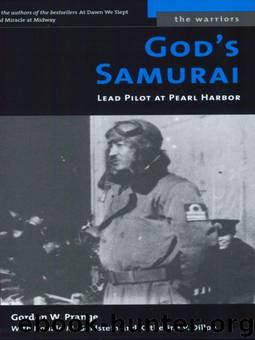God's Samurai: Lead Pilot at Pearl Harbor (The Warriors) by Katherine V. Dillon & Donald M. Goldstein & Gordon W. Prange

Author:Katherine V. Dillon & Donald M. Goldstein & Gordon W. Prange [Dillon, Katherine V.]
Language: eng
Format: epub, mobi
Publisher: Potomac Books Inc. - A
Published: 2003-11-29T16:00:00+00:00
21
“More Trouble Is Coming!”
THE DAY FOLLOWING the emperor’s broadcast, Ozawa and Fuchida closed Combined Fleet headquarters at Hiyoshi and removed it to the Meguro War College in Tokyo. Those who still had a work program mapped out were fortunate—it tided them over the first shock of defeat. Fuchida’s main concern was that he and his fellow officers get through the distasteful business of surrender with their dignity unimpaired. In his opinion, they could only do this by preparing for occupation with the same thoroughness they had given the war effort.
Many of his associates couldn’t be so detached, particularly those of lesser rank who had nothing left to do. Deprived overnight of their way of life and reason for living, many panicked when they realized that Japan had indeed lost the war, and that occupation forces would take over in a matter of days. Some stole aircraft and flew to remote locations; others commandeered trucks and raced away in aimless flight from unbearable reality. Rumors floated about that the Allies would behead all Japanese officers. In a number of places, demoralized men set fire to navy buildings. Hungry townspeople surged into some of the almost deserted navy bases to loot. “The situation was just like revolution,” Fuchida recalled—a nasty preview of what conditions might become when the armed forces were turned loose without employment.
While Ozawa and Fuchida settled into the Naval War College, the institution’s press turned out a thousand copies of Fuchida’s pamphlet, “We Believe This.” The college rushed distribution to all naval bases inside and outside Japan to clarify the situation for young officers and to enlist their cooperation. Fortunately, the tract enjoyed immediate success, helping many to accept the inevitable. But stubborn pockets of opposition remained.1
After the abortive coup, troops from outside the Tokyo area were rushed in to replace the palace guard, which could no longer be considered reliable. A replacement platoon from Ibaraki Prefecture revolted and seized Ueno Hill, but shortly was persuaded to disperse. The young officers who had led the revolt committed suicide. Another group occupied Atagi Hill; soon thereafter the entire group blew themselves up with hand grenades.2
Fuchida realized the extent and nature of the resistance when he made arrangements for the flight of Japan’s peace delegates to Manila. MacArthur had stipulated that the delegates fly from Haneda to Kisarazu, thence to Okinawa in two planes painted white and marked with a green cross on the wings and body. At Okinawa the delegates would transfer to U.S. aircraft. Ozawa authorized Fuchida to secure a Douglas DC from Yokosuka for the first leg. But when Fuchida phoned the order to Captain Kogure, he refused to comply. “The Yokosuka antisurrender group has agreed to work with Kozono at Atsugi in establishing a picket line in the air across Japan between the two bases to shoot down any surrender plane that tries to fly to Okinawa,” he said.3
Fuchida sizzled with wrath at Kogure and Kozono, both old enough to know better. But he felt sorry for the rebel pilots.
Download
God's Samurai: Lead Pilot at Pearl Harbor (The Warriors) by Katherine V. Dillon & Donald M. Goldstein & Gordon W. Prange.mobi
This site does not store any files on its server. We only index and link to content provided by other sites. Please contact the content providers to delete copyright contents if any and email us, we'll remove relevant links or contents immediately.
| Afghan & Iraq Wars | American Civil War |
| American Revolution | Vietnam War |
| World War I | World War II |
Waking Up in Heaven: A True Story of Brokenness, Heaven, and Life Again by McVea Crystal & Tresniowski Alex(37031)
Empire of the Sikhs by Patwant Singh(22202)
We're Going to Need More Wine by Gabrielle Union(18101)
Hans Sturm: A Soldier's Odyssey on the Eastern Front by Gordon Williamson(16981)
Leonardo da Vinci by Walter Isaacson(11944)
The Radium Girls by Kate Moore(10939)
Educated by Tara Westover(7093)
Tools of Titans by Timothy Ferriss(6994)
How to Be a Bawse: A Guide to Conquering Life by Lilly Singh(6721)
The Last Black Unicorn by Tiffany Haddish(5091)
Permanent Record by Edward Snowden(5025)
The Rise and Fall of Senator Joe McCarthy by James Cross Giblin(4858)
Promise Me, Dad by Joe Biden(4470)
The Wind in My Hair by Masih Alinejad(4437)
The Crown by Robert Lacey(4125)
A Higher Loyalty: Truth, Lies, and Leadership by James Comey(4051)
The Iron Duke by The Iron Duke(3663)
Joan of Arc by Mary Gordon(3281)
How to be Champion: My Autobiography by Sarah Millican(3202)
